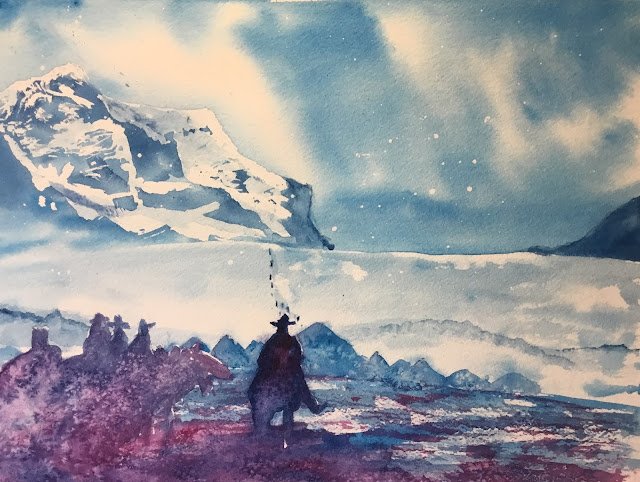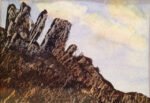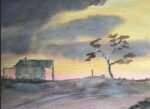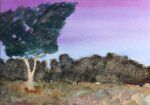30 October 2013 Here are some rocks. The painting is based on a photo of…

The Far Country
I was feeling keen to start putting some of these Bridget Woods lessons into practice. Part of the lesson was to put together the monotone painting that you saw in the previous post, which used only the Daler Rowney tube of pthalo blue that I’ve had sitting around for a while. I was keen to keep using that blue so picked this scene from The Far Country (1954 Western starring James Stewart, set in the Yukon). But to get a little more variation, I also used a second cool blue (Prussian) and a cool red for a bit of contrasting warmth (permanent rose). There’s no yellow in there, so I can’t say this is in a particular colour key.
I started with a rough pencil sketch, then masked out the foreground silhouettes and reserved some whites in the mountain in the top left. I also spattered over some masking fluid to look a bit like falling snow. Then I painted the sky in pthalo blue, using Bridget Woods’ very prescriptive wet into wet techniques. At the same time, I painted in both mountains. The one on the left used Bridget’s wet into dry techniques; the one on the left was separated from the sky by masking fluid, so I was able to paint it in with both blues without having to wait for the sky to dry.
Then I added the middleground using both blues. I added the tents before it was dry. I wasn’t concerned about getting them or the riders into focus as the top left mountain was going to be in focus. You camn’t focus on background and foreground at the same tone in real like, so why should both be in focus in a painting? The row of posts and the jaggedy hill lines near the foreground were both added much later. So far, I’ve only used the two blues.
Next was the foreground. To make it look churned up, muddy and slushy, I used Bridget’s dry onto dry technique, using the texture of the paper to create texture in the brushstrokes. I was now using permanent rose as well as the two blues.
Then the masking fluid came off. There was a bit too much white in the mountain, so I washed some very dilute Prussian blue over the most shadowy bits.
Finally, I added in the foreground figures. I didn’t want to pick out individual horses and raiders, so just treated them as two silhouettes, painting in a variegated mix of all three colours. I added shadows underneath, not distinguishing the shadows form the silhouettes. I added some extra, darker churned up strokes to the foreground to on next it to the figures. And then I added some more paint to the tents and threw on some salt.
This is definitely an acceptable painting and was quickly snapped up by the Scottish collector who already has a number of my other pieces. It’s the sky and the mountain that are the high points on this one, although the middleground snow and churned up foreground are also good. There’s even a bit of fog that’s appeared at the foot of the top left mountain and may even be covering part of the middleground. The figures and tents are the weakest element of the painting. It’s a shame the silhouette on the right is more blue and less purple than the one on the left. And the salt marks aren’t perfect. Still, until Roy Keane is let loose on my artwork, I’ll always be my own worst critic.








Leave a Reply